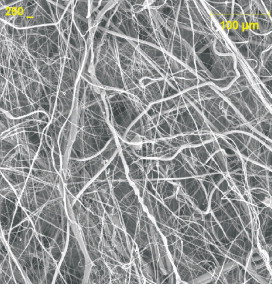We are using nanofiber products in our daily life, such as nanofiber filter media.
Among the most prominent methods of producing nanofibers is the electrospinning method. This process involves the use of a hypodermic needle, nozzle, capillary or movable emitter. These tools provide liquid solutions of the polymer that are then attracted to a collection zone by a high voltage electrostatic field. As the dissolved polymer and solvents are pulled from the emitter and accelerated through the electrostatic zone, fibres are formed through a process of solvent evaporation.

While electrospinning is effective for producing nanofibers, it has drawbacks. At the outset, electrospinning is a very slow process for producing nanofibers on a commercial scale, which increases manufacturing costs. Electrospinning also produces a largely two-dimensional structure that lacks depth or z-directionality. While this configuration is desirable for surface loading, it has limited capability for depth loading applications. Electrospun nanofibers tend to be fairly weak and can be easily damaged or dislodged from the substrate. There remains a need for enhanced nanofibers that overcome the deficiencies of current electrospun nanofibers.
The development of nanofibers has become more prominent in recent years, due to their ability to enhance the performance of filter media, the foundation of efficient air filtration for buildings and other uses.
Learn more nanofiber filter media or dust collector air filter media via chentai.net.